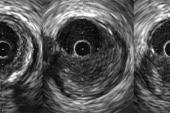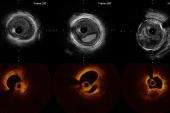Pay Now, Save Later: Intracoronary Imaging for PCI Cost-effective Over Lifetime
Findings from the Korean RENOVATE-COMPLEX-PCI trial support a change in guidelines favoring IVUS and OCT, researchers say.

Intracoronary imaging to guide complex PCI cases is initially more expensive than angiographic guidance but grows to be more cost-effective over a lifetime given the lower associated medical costs and improved quality of life, according to a subanalysis of the Korean RENOVATE-COMPLEX-PCI trial.
The findings should bolster the use of IVUS and OCT in routine clinical practice, the researchers argue.
“The current results support the superior cost-effectiveness of intravascular imaging-guided PCI [over] angiography-guided PCI, [and] will provide more strong support for the use of intravascular imaging devices in PCI for complex coronary artery lesions,” senior author Joo Myung Lee, MD, PhD (Samsung Medical Center, Sungkyunkwan University School of Medicine, Seoul, Republic of Korea), told TCTMD in an email.
With worldwide use of intracoronary imaging now hovering between 10% and 20%, these and other data support a change in guidelines to support its use with a class 1A recommendation “at least for patients with complex coronary artery lesions,” he added.
Numerous studies have demonstrated significant benefits of intracoronary imaging during PCI with regard to both long-term outcomes as well as mortality, and the main results of the RENOVATE-COMPLEX PCI trial, as covered by TCTMD, showed a significant drop in the risk of target vessel failure for those randomized to imaging-guided PCI with either IVUS or OCT compared with angiography over a median follow-up of 2.1 years. In addition, the American College of Cardiology (ACC) published a consensus statement in 2023 urging more use of this technology.
However, while many Asian and European operators have changed their practice to incorporate this kind of imaging during their procedures, American physicians have been more reticent.
Alexander G. Truesdell, MD (Inova Heart and Vascular Institute, Falls Church, VA), who served as lead author for the ACC statement, said the study represents another step in the right direction for imaging-guided PCI. “If you look at the sum total of data for intracoronary imaging, it's accruing only in one direction,” he told TCTMD. “There is no data that is pushing us back. Everything is in favor of imaging, and predominantly in favor of complex lesion subsets like they looked at in RENOVATE. . . . I think all of the data, bit by bit, will help.”
Truesdell agreed that a guideline change, at least for complex PCI, is likely not “that far off.”
So did Toshiki Kuno, MD, PhD (Montefiore Medical Center, Albert Einstein College of Medicine, Bronx, NY). He told TCTMD “these data are supportive to change the guideline to class 1 for IVUS,” but also acknowledged that cost-effectiveness analyses haven’t historically done much to change physician preference.
Cost-effectiveness Analysis
For the subanalysis, published online this week in Circulation: Cardiovascular Quality and Outcomes, David Hong, MD (Samsung Medical Center, Sungkyunkwan University School of Medicine), Lee, and colleagues compared costs among the 1,639 patients undergoing complex PCI in the main trial who were randomized in a 2:1 fashion to intracoronary imaging- or angiography-guided PCI.
However, when the researchers performed a simulation looking at the projected lifetime events and costs for patients, cumulative medical costs were significantly lower for those in the intracoronary imaging arm compared with angiography ($40,455 vs $49,519), with QALY being consistently higher (8.24 vs 7.89). This drove a dominant ICER of -$9,959 per QALY gained. The total cumulative medical costs reversed to favor intravascular imaging at about 5 years.
Multiple sensitivity analyses confirmed these results, even when the hazard ratio of cardiac death and spontaneous MI in the two groups was assumed to remain stable after 1, 3, and 10 years of follow-up.
Lee said he was not surprised to see initially higher costs with intravascular imaging-guided PCI. “What is more interesting is that cumulative medical costs are getting higher and higher in the angiography-guided PCI group because of a higher incidence of death, myocardial infarction, and target vessel revascularization,” he said.
Although the data, including costs, were limited to Korean patients, Lee argued that the results are generalizable globally.
“It should be noted that the medical cost following intravascular imaging-guided PCI in Korea is about $2,000, which is similar to the cost in United States, as far as I know,” he said. “Considering that the overall healthcare costs are much higher in United States than Korea, every effort to improve patient prognosis is essential to ultimately reduce total cumulative medical costs during lifetime follow-up of patients.”
Nevertheless, he continued, the researchers plan to continue to gather longer-term follow-up and perform subsequent cost-effectiveness analyses in the coming years.
Globally Generalizable?
In an accompanying editorial, Serge Korjian, MD (Beth Israel Deaconess Medical Center, Boston, MA), and Suzanne J. Baron, MD (Massachusetts General Hospital, Boston, MA), write that the study “offers crucial insights into the economic viability of intravascular imaging utilization in complex PCI” but say any cost-effectiveness analysis will be limited by its global/regional perspective.
Using intravascular imaging, for example, is likely more expensive at the outset in the United States, according to the editorial.
Another limitation is that the short 3-year study period might not be long enough to determine the true benefit of intravascular imaging given the large initial costs. Then again, assuming the clinical benefits (namely improvement in survival and decreased rates of myocardial infarction) continue to accrue in a linear fashion across the patient’s lifetime is also questionable.
“This likely leads to an exaggerated estimation of the economic benefit of intravascular imaging because it is not clear that intravascular imaging will continue to offer the same degree of cardiovascular benefit in both the early and late time periods after PCI,” write the editorialists.
Korjian and Baron also highlight that not all studies of intravascular imaging have demonstrated improved clinical outcomes, citing ILUMIEN IV, which did not show a difference in target vessel failure or mortality at 2 years. Without these kinds of benefits, it’s not a given that intravascular imaging will show the same kinds of cost-effectiveness gains over angiography guidance in the long term, they add.
“Still, there is little dispute that intravascular imaging is an indispensable asset in optimizing procedural results in complex PCI,” the editorialists note, “and with the growing body of evidence indicating that it also improves patient outcomes, it has become even more important to ensure that economic considerations do not act as a barrier for the uptake of intravascular imaging.”
Breaking Down Barriers
One of the main impediments Truesdell hears from colleagues about using intracoronary imaging is cost, but that can mean something different depending on how a hospital plans its budget, he said. “The question is: would you rather save a dollar over a year or lose five cents today? In the end you would rather save the dollar, but if you are going on a daily budget or a quarterly budget, you are not looking that far out.”
Another hurdle to more intravascular imaging use is the perception that it will lengthen procedure time, he said. With the right planning and infrastructure in place, however, this can be overcome, he said.
As more cost analyses like these come out with positive news from all parts of the world with different lesion subsets and patients, no matter the exact intracoronary imaging modality used, he expects behavior to change. “If you get more global accrual of data, that leads to guideline change, which leads to requirements for reporting data tied to changes in payment, and that story is completely written at that point,” Truesdell said, alluding to similarities with how transradial access came to be routine practice for PCI.
“The parallels with radial are really fascinating to me because whenever you are doing a practice change, a behavioral change, there's learning curve, there's cost issues, there's safety issues, there's outcomes issues, and they all sort of converge,” he concluded. “The behavior lags behind the data. But it's great to see all the data continually headed in one direction from a lot of countries.”
Yael L. Maxwell is Senior Medical Journalist for TCTMD and Section Editor of TCTMD's Fellows Forum. She served as the inaugural…
Read Full BioSources
Hong D, Lee J, Lee H, et al. Cost-effectiveness of intravascular imaging-guided complex PCI: prespecified analysis of RENOVATE-COMPLEX-PCI trial. Circ Cardiovasc Qual Outcomes. 2024;17:e010230.
Korjian S, Baron SJ. Seeing beyond the surface: is intravascular imaging cost-effective? Circ Cardiovasc Qual Outcomes. 2024;17:e010745.
Disclosures
- This trial is investigator-initiated with grant support from Abbott Vascular and Boston Scientific.
- Hong, Korjian, and Kuno report no relevant conflicts of interest.
- Baron reports receiving institutional research support from Boston Scientific Corporation, Abiomed, and Acarix; speaking honoraria from Edwards Lifesciences, Shockwave, Zoll Medical, Medtronic, and Boston Scientific Corporation; and consulting/advisory board fees from Medtronic, Zoll Medical, and Boston Scientific Corporation.
- Truesdell reports serving as a consultant for Abiomed.





Comments